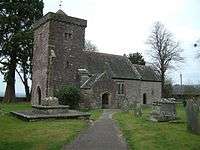St Andrew's Church, Tredunnock
| Church of St Andrew, Tredunnock | |
|---|---|
| Church of St Andrew | |
 "a very attractive and well preserved medieval church" | |
 Church of St Andrew, Tredunnock Location in Monmouthshire | |
| Coordinates: 51°38′57″N 2°53′52″W / 51.6491°N 2.8977°W | |
| Location | Tredunnock, Monmouthshire |
| Country | Wales |
| Denomination | Church in Wales |
| History | |
| Status | Parish church |
| Founded | C12th-C13th century |
| Architecture | |
| Functional status | Active |
| Heritage designation | Grade II* |
| Designated | 18 November 1980 |
| Architectural type | Church |
| Style | Perpendicular |
| Administration | |
| Parish | Tredunnoc |
| Deanery | Raglan/Usk |
| Archdeaconry | Monmouth |
| Diocese | Monmouth |
| Clergy | |
| Vicar(s) | The Reverend K J Hasler |
The Church of St Andrew, Tredunnock, Monmouthshire is a parish church with its origins in the 12th or 13th century. A Grade II* listed building, the church remains an active parish church.
History
Two lancet windows in the chancel may be Norman, giving a foundation in the 12th century[1] but the earliest recorded mention of the church is from the mid-13th century.[1] Most of the current structure dates from the 15th or 16th centuries, including the porch. The font and the top of the tower are 17th century.[1]
An extensive restoration of the church took place in the early 20th century. The architect was Arthur Grove and a Portland stone tablet by Eric Gill, dated 1910, records the restoration.[1] The Monmouthshire author and artist Fred Hando recorded that the churchyard held the grave of Eleanor Isabella Gill, only child of Sir John Franklin, the Arctic explorer.[2]
Architecture and description
The church is constructed of Old Red Sandstone and the style is Perpendicular.[1] The interior contains a Roman grave-slab, described by the architectural historian John Newman as, "splendidly lettered and well-preserved".[3] It commemorates Julius Julianus, a soldier with the Second Augustan Legion based at Isca Augusta, now Caerleon.[3] The porch contains an early tablet by Eric Gill.[3] In his Journeys in Gwent, published in 1951, Hando recalled that, "For half a millennium the country-folk of Tredunnock have worshipped in their lovely brown church". St Andrew's is a Grade II* listed building,[1] its listing recording it as "a very attractive and well preserved medieval church".[1]
Notes
- 1 2 3 4 5 6 7 "Listed Buildings - Full Report - HeritageBill Cadw Assets - Reports". cadwpublic-api.azurewebsites.net. Retrieved 2017-08-03.
- ↑ Hando 1951, pp. 30-31.
- 1 2 3 Newman 2000, p. 572.
References
- Hando, Fred (1951). Journeys in Gwent. Newport: R. H. Johns Ltd. OCLC 30202753.
- Newman, John (2000). Gwent/Monmouthshire. The Buildings of Wales. London: Penguin. ISBN 0-14-071053-1.